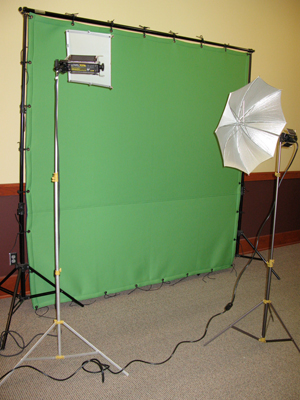(Editor’s note: This is the first in a series on the Media Development Center’s new green screen, which is available for K-State students, faculty, and staff to use on still images and video.)
People who go to the Media Development Center (MDC), 214 Hale Library, may have noticed a large green (or blue) screen near the entryway in the past few months. This is known colloquially as a “green screen” because it allows graphic artists and video editors to change the backgrounds of images. For example, this is the tool that allows meteorologists to share information on moving weather systems.
A green screen is used in professional broadcast television studios to capture a person or people in the foreground while the background image may be dynamic. Then, the background may be “keyed” (chroma-keyed) or eliminated, and different backgrounds put into the place of the green/blue screen.

Using different backgrounds offers opportunities for artistic effects, portraiture effects, and other types of contextualization.
This series will discuss ways to use the green screen for still images. It will also describe ways to use this for digital video.
Using evenly lit backgrounds
During the still-image or video capture, it is important to have the background as evenly lit as possible. However, even with poor lighting, still-image and video editors will often be able to render the images they need.
Clothing and makeup
The subject(s) in the image and video captures should not wear a color similar to the background color, or else that part of their clothing (or makeup) will disappear. Also pay attention to clothing patterns that may contain the background color.
Video examples
These YouTube videos show the basics of using a green screen and how to create several special effects.
- Basics: Green Screen Effects
- Special effects: Videomaker’s Favorite Green Screen Effects
Next in this series: Editing still images for the green (+blue) screen.